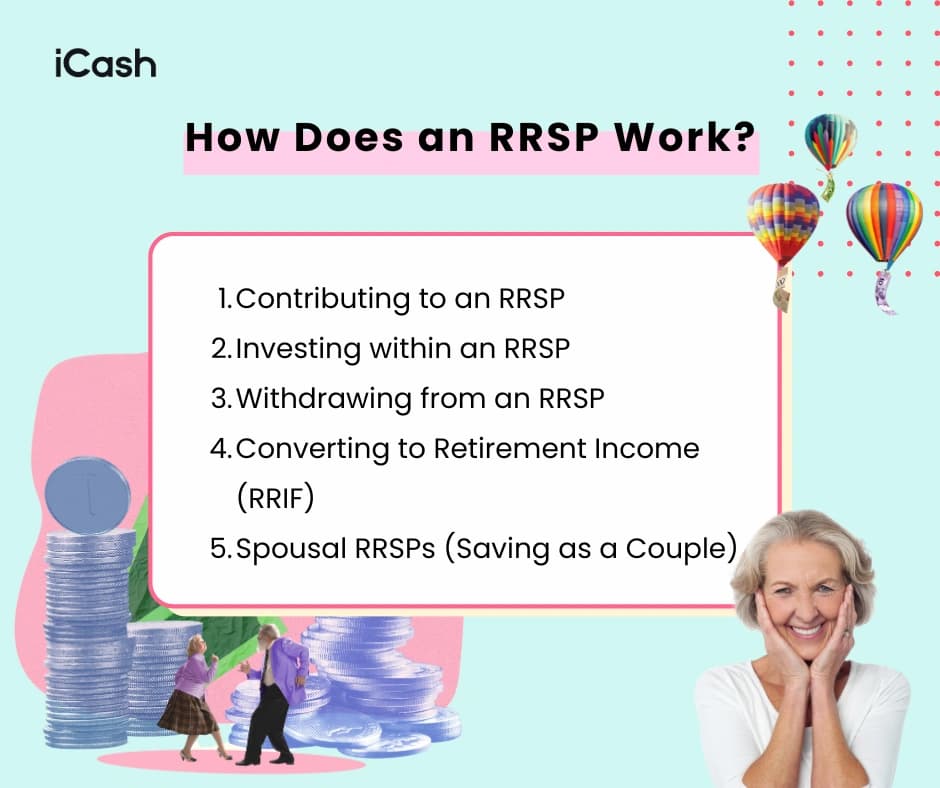Saving for retirement can be confusing, especially with all the acronyms and options out there. One term you’ve likely heard is RRSP, which stands for Registered Retirement Savings Plan.
If you’re a Canadian with little background in finance, don’t worry – we’ll break down exactly what an RRSP is, how it works, and why it’s a popular tool for retirement planning.
What Is an RRSP?
An RRSP (Registered Retirement Savings Plan) is a special type of account designed to help Canadians save for retirement. What makes it “registered” is that it’s registered with the federal government (specifically, the Canada Revenue Agency).
You open an RRSP at a bank or financial institution, and the government gives it special tax treatment. In simple terms, an RRSP lets you put away money during your working years and get tax advantages for doing so.
Here are the basics of an RRSP:
Tax Deduction for Contributions: When you contribute money to an RRSP, you can deduct that amount from your taxable income on your tax return.
Tax-Sheltered Growth: The money inside your RRSP (and any investment earnings it generates) grows tax-free while it stays in the account.
Taxable Withdrawals in Retirement: An RRSP is meant to eventually provide you with retirement income. When you withdraw money from your RRSP, it will be taxed as normal income at your then-current rate.
In short, an RRSP is an account for retirement savings in Canada that gives you an immediate tax benefit and shelters your investment growth from taxes until you take the money out.
You can set up an RRSP for yourself, and even you, your spouse, or common-law partner can contribute to one (more on spousal RRSPs below). It’s a fundamental part of many Canadians’ retirement plans.
How Does an RRSP Work?

Here’s how each stage of an RRSP works—from contributing and investing to withdrawing and converting it into a retirement income stream.
Contributing to an RRSP
Each year, you can contribute up to 18% of your previous year’s earned income, up to a set maximum (e.g., $31,560 for 2024), plus any unused contribution room from previous years.
Contributions made within the first 60 days of the year can be applied to the previous tax year. You’ll receive a tax deduction, which lowers your taxable income and may result in a refund. The higher your income, the more valuable the deduction.
Investing within an RRSP
An RRSP isn’t an investment—it’s an account that holds investments like mutual funds, GICs, stocks, bonds, or ETFs. Any growth or income earned stays tax-sheltered while in the plan.
Withdrawing from an RRSP
Withdrawals are taxed as income in the year you take them out. If you withdraw early, a withholding tax applies, ranging from 10% to 30% depending on the amount. These withdrawals also permanently reduce your contribution room.
Exceptions include the Home Buyers’ Plan and Lifelong Learning Plan, which allow temporary tax-free withdrawals that must be repaid over time.
Converting to Retirement Income (RRIF)
By December 31 of the year you turn 71, your RRSP must be converted to a Registered Retirement Income Fund (RRIF) or annuity. A RRIF lets your investments keep growing tax-free, but you’re required to withdraw a minimum amount annually, and those withdrawals are taxed as income.
Spousal RRSPs (Saving as a Couple)
If you’re married or in a common-law partnership, there’s a special type of RRSP strategy to know about: the Spousal RRSP.
A spousal RRSP is simply an RRSP that is opened in your spouse’s (or common-law partner’s) name, but you contribute to it. Why would you do that? The reason is to help couples balance their retirement savings and lower their overall tax bill as a family.
Here’s how a spousal RRSP works: Suppose one spouse earns significantly more than the other. The higher earner can contribute to an RRSP in the lower earner’s name (designating it as a spousal contribution).
The contributor (higher earner) still gets the tax deduction for the contribution, just as if they put the money into their own RRSP.
However, the money actually belongs to the spouse in whose name the RRSP is opened. When that spouse eventually withdraws the money in retirement, it will be taxed in their hands.
What Can You Hold in an RRSP?
Fortunately, RRSPs are very flexible in terms of investment choices. You are not limited to just a savings account or a single type of investment.
Qualified investments for RRSPs include:
Cash deposits and Savings accounts
Guaranteed Investment Certificates (GICs)
Bonds and other fixed-income investments
Stocks (Equities)
Mutual Funds and ETFs
Other allowed assets
The important thing is that all the earnings from these investments are sheltered from income tax while inside the RRSP, which can make a big difference over decades of saving.
RRSP vs. TFSA: What’s the Difference?
Two of the most popular savings vehicles in Canada are RRSPs and TFSAs. A TFSA stands for Tax-Free Savings Account, and it’s another type of registered account with tax advantages.
A common question is: RRSP or TFSA – which is better?
The truth is, both have their benefits and serve different purposes.
Let’s compare them in simple terms:
Tax treatment: RRSPs offer a tax deduction when you contribute, but withdrawals are taxed later. TFSAs don’t give a deduction, but all growth and withdrawals are completely tax-free.
Purpose: RRSPs are geared toward retirement. TFSAs can be used for anything—emergency savings, a big purchase, or retirement—because you can withdraw anytime without tax or penalty.
Contribution limits: RRSP room depends on your income (18% up to a yearly cap), while TFSA limits are the same for everyone. TFSA room also resets when you withdraw, unlike RRSPs, where withdrawn room is lost.
Age limits: You can only contribute to an RRSP until age 71. TFSAs have no age cap—you can keep contributing for life as long as you’re 18 or older.
Income impact: RRSP withdrawals are taxed, affecting government benefits like OAS. TFSA withdrawals don’t count as income, making them useful for retirees looking to avoid benefit clawbacks.
So, which is better? It depends. High earners may benefit more from RRSPs, while lower-income individuals may find TFSAs more advantageous. Many people use both RRSPs for long-term savings and TFSAs for flexibility and tax-free growth.
How Does an RRSP Work in Canada?
An RRSP works as a tax-advantaged retirement savings account. You contribute money to your RRSP (up to your annual limit), and those contributions are deducted from your income, giving you a tax break in the current year.
The money in the RRSP is then typically invested (for example, in stocks, bonds, GICs, mutual funds, etc.) and it grows tax-free over time.
You don’t pay any tax on the investment earnings as long as they stay in the plan. When you retire or need to use the money, you withdraw it from the RRSP, and at that point, the withdrawal is added to your income and taxed.
What Are The Disadvantages Of An RRSP?
RRSPs have many benefits, but it’s important to be aware of their drawbacks too.
Here are some common disadvantages of RRSPs to consider:
Withdrawals are taxable
Contribution limits
Lost room on withdrawal
Mandatory withdrawals at 71
Less benefit for low incomes
Despite these drawbacks, RRSPs can still be very worthwhile. It’s all about using the account in the right way (for long-term retirement saving, when you can really take advantage of the tax deferral).
What’s Better, RRSP or TFSA?
This is a very common question, and the answer is that it depends on your situation. Neither account is strictly “better” universally – they each have pros and cons, and many Canadians benefit from using both.
If your income is high now and likely lower in retirement, an RRSP can lower your overall tax bill. If your income is low, a TFSA may be more beneficial since withdrawals are tax-free and don’t affect your contribution room.
TFSAs offer more flexibility for early access, while RRSPs are better suited for long-term retirement savings, especially if employer matching is available. Many Canadians use both to balance tax savings and access.
How Much Will I Get Back If I Put $10,000 in My RRSP?
The amount of tax refund or savings you get from a $10,000 RRSP contribution depends on your marginal tax rate (your tax bracket).
Canada’s income tax system is tiered, combining federal and provincial rates, so your marginal tax rate could range anywhere from 20% to 50% (approximately) depending on your income and province.
For a simple example, let’s say your combined federal/provincial marginal tax rate is 30%.
A $10,000 RRSP contribution would save you about 30% of $10,000 in taxes – that’s $3,000. In other words, you could expect around a $3,000 higher refund (or reduction in taxes owing) at tax time because of that contribution.
If you were in a higher bracket, say 40%, the same $10,000 contribution would save you about $4,000 in tax. In general, you “get back” an amount equal to your contribution times your marginal tax rate.
Stay on Track With Your Retirement Savings
Looking to free up room in your budget so you can contribute more to your RRSP?
iCash.ca offers fast, flexible short-term loans to help you manage unexpected expenses—without derailing your long-term savings goals. Responsible borrowing today can help you stay on track for tomorrow’s retirement.











